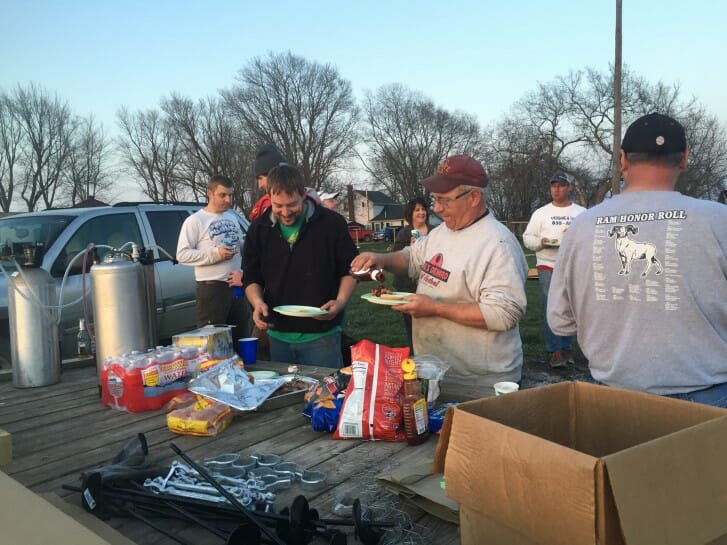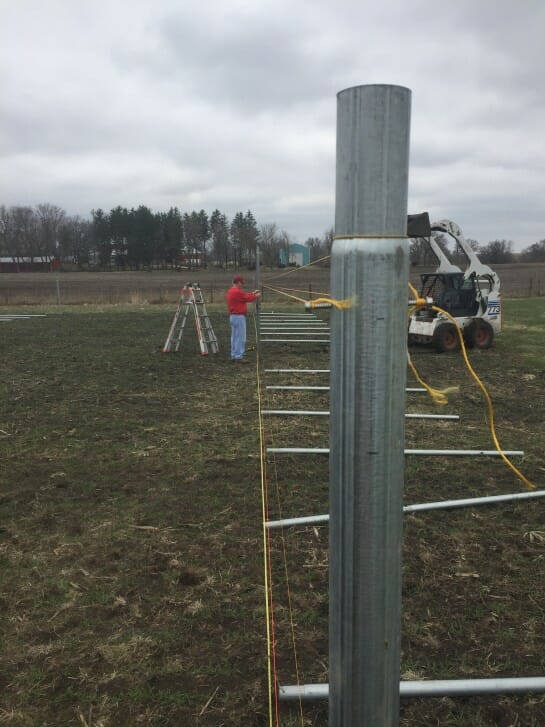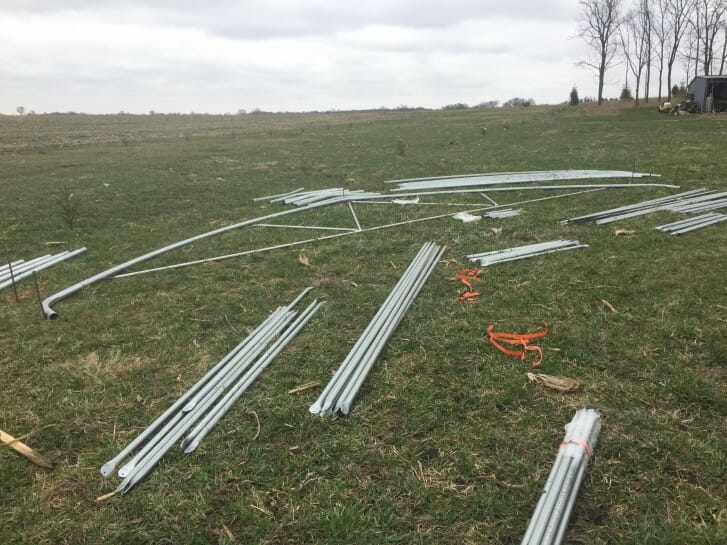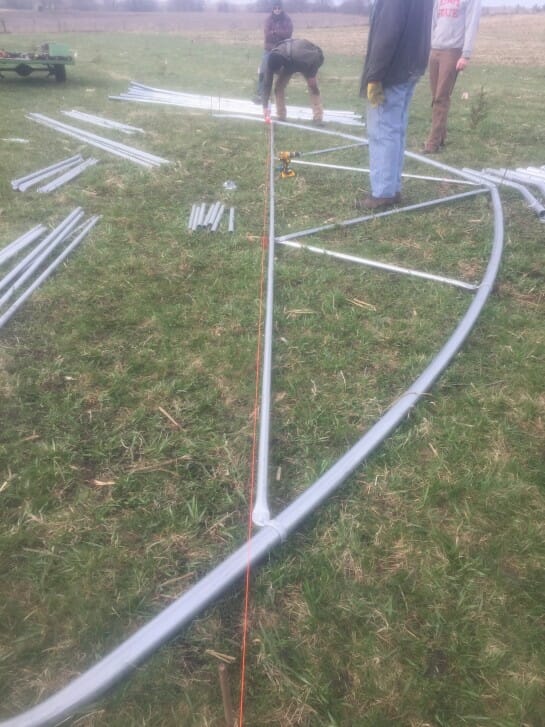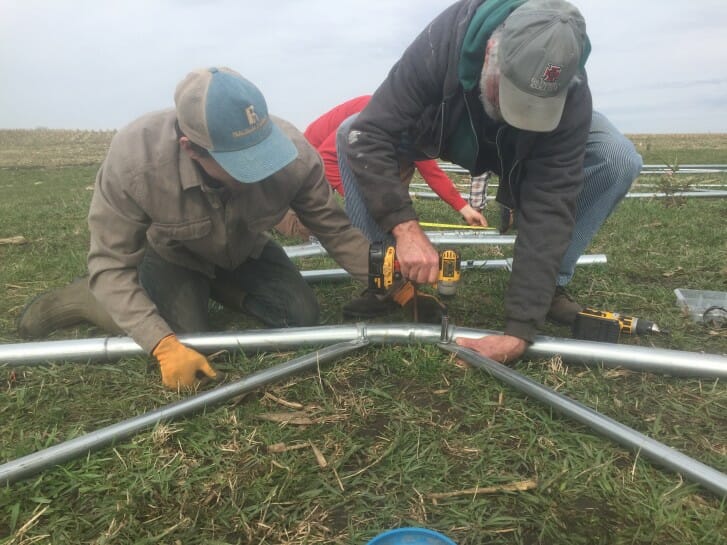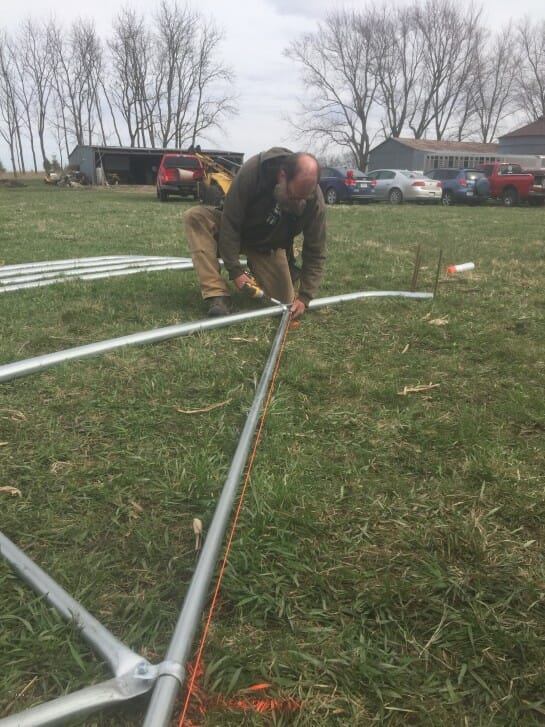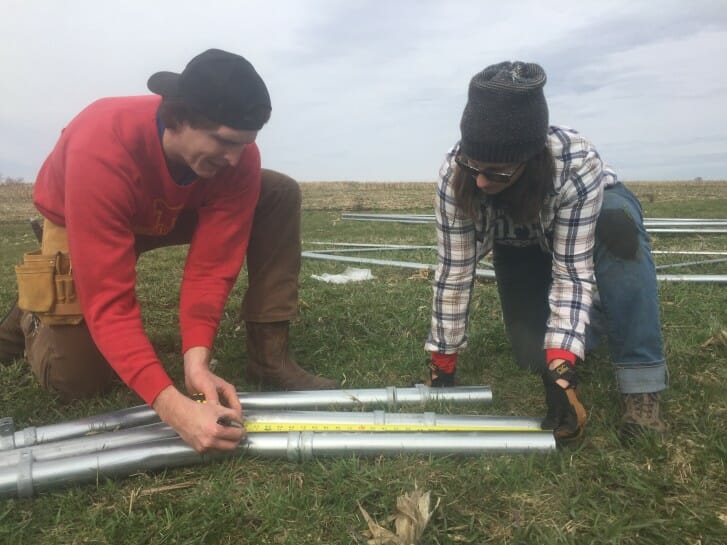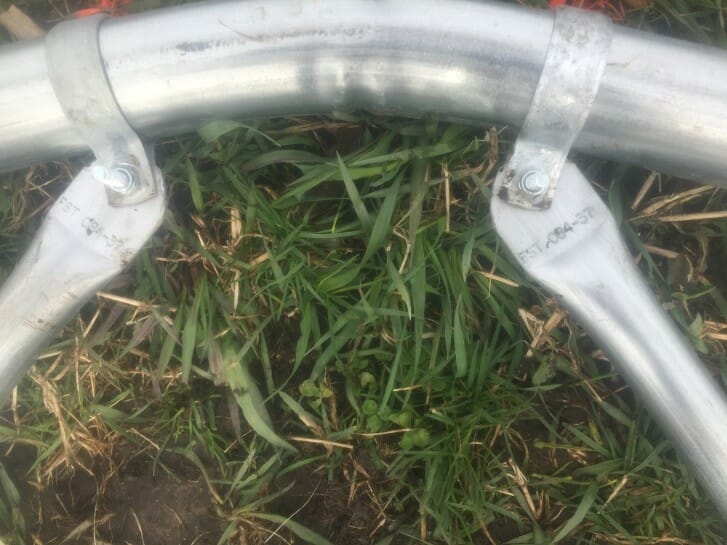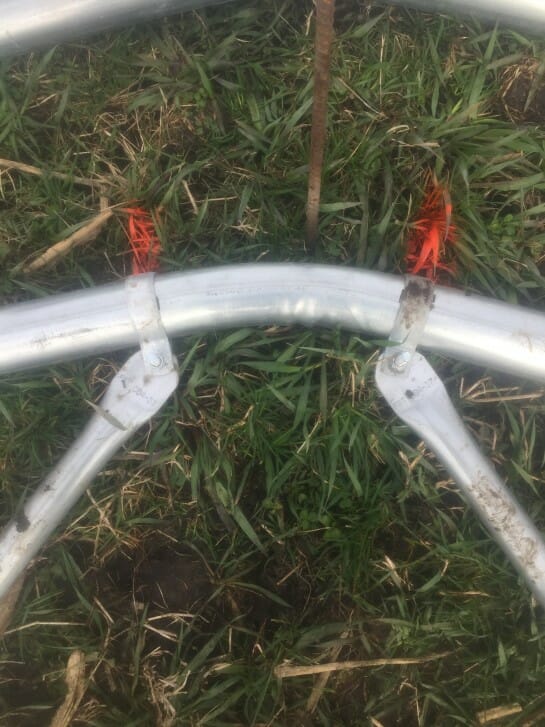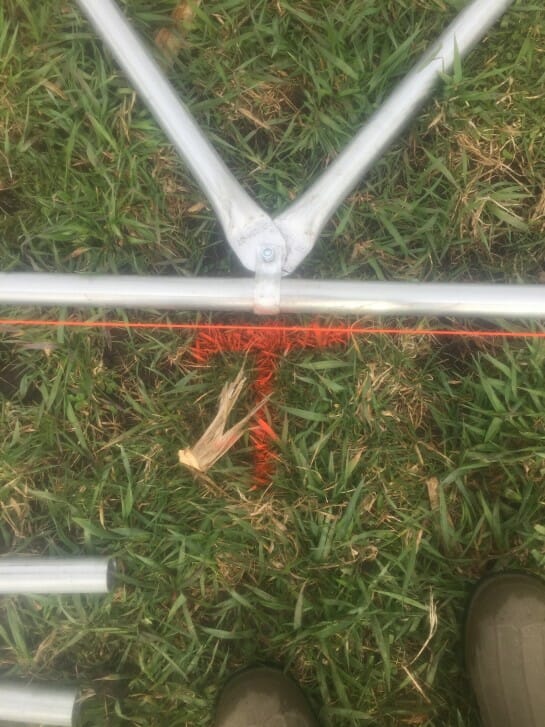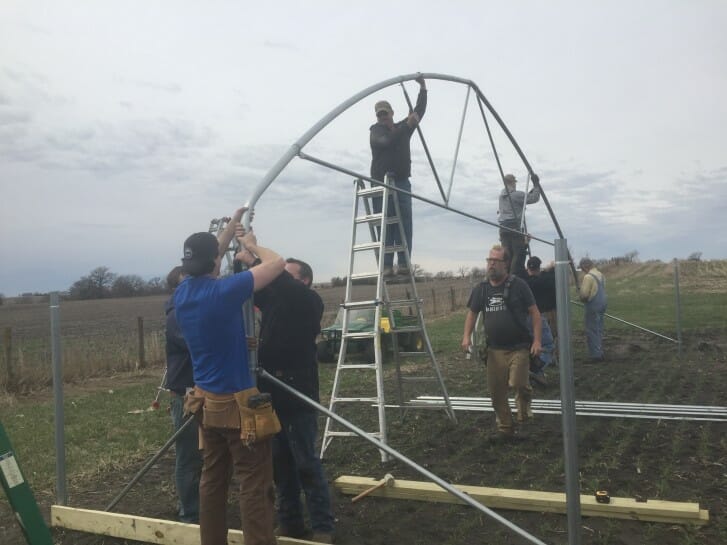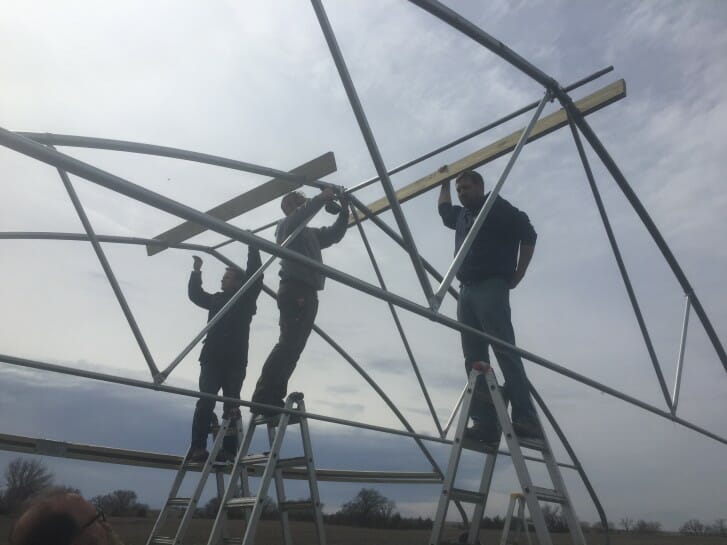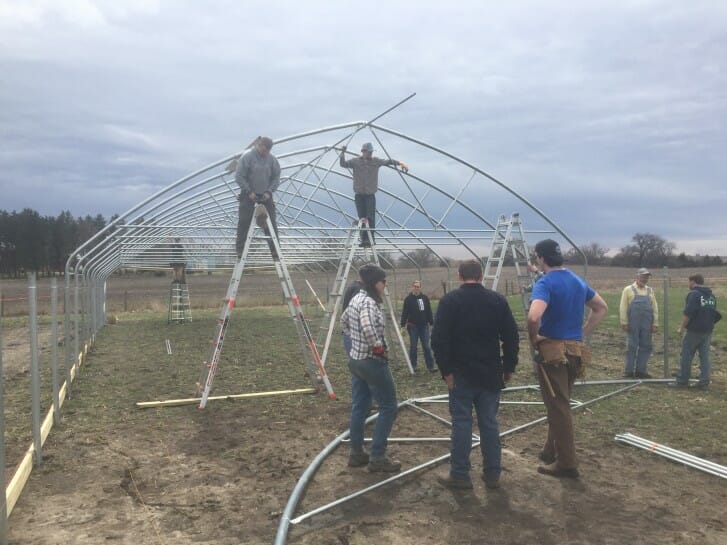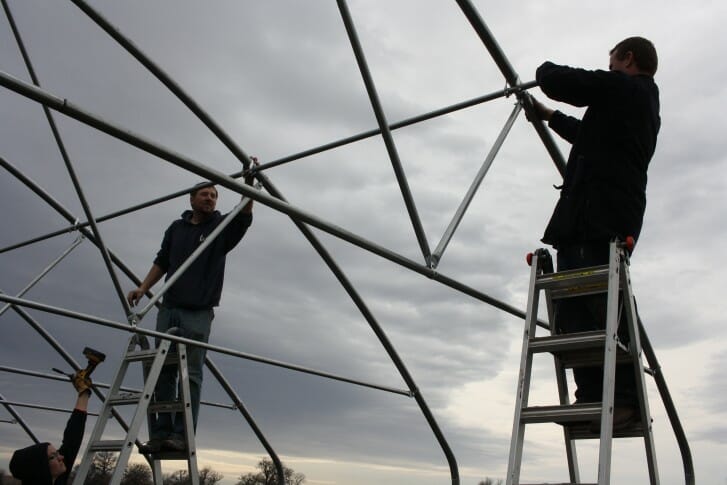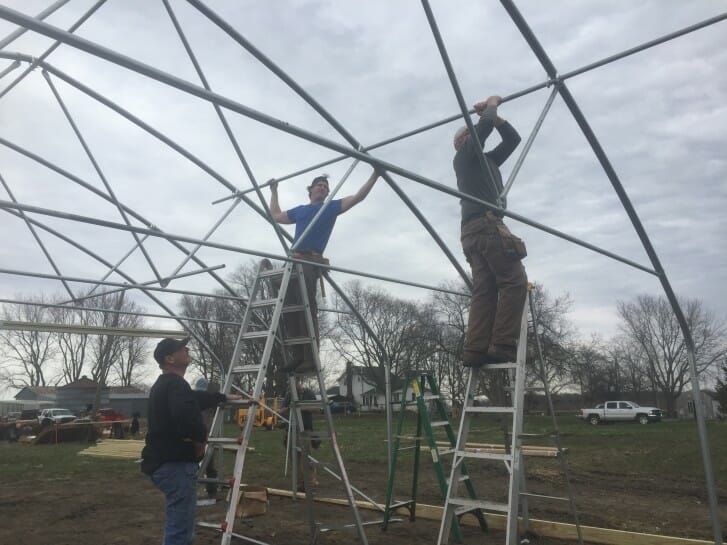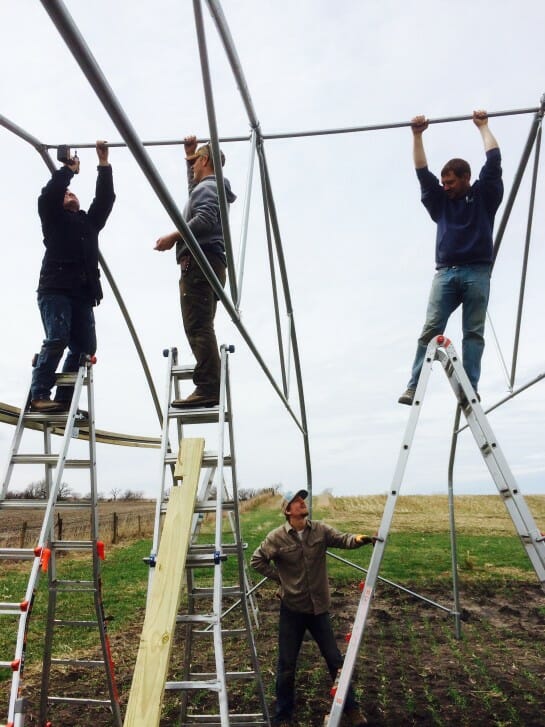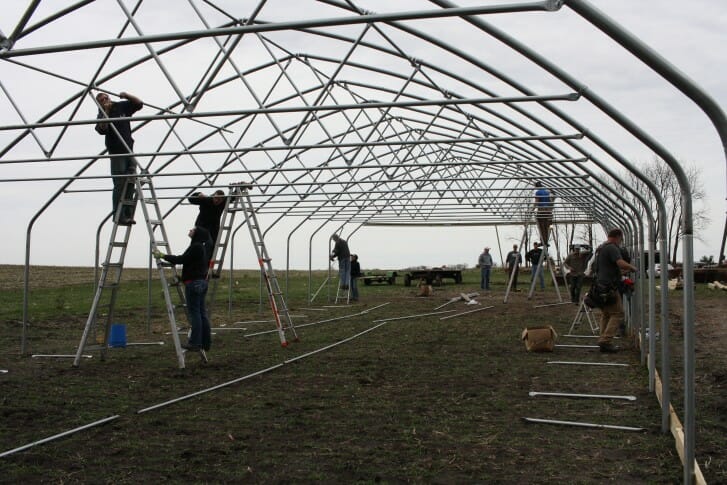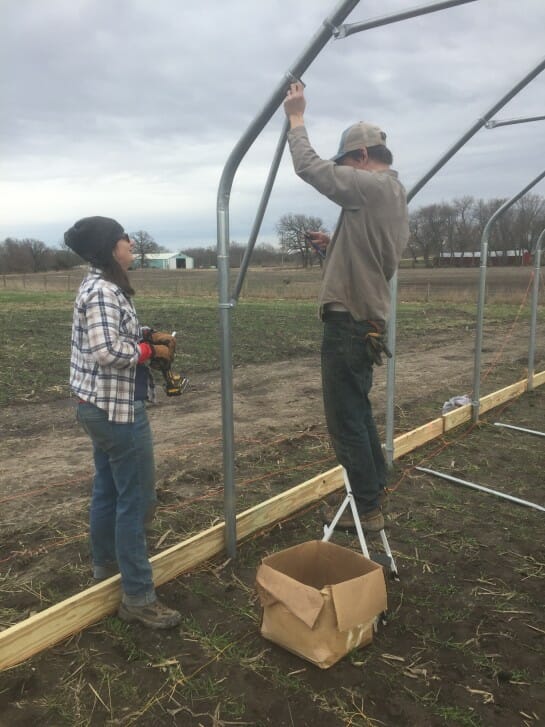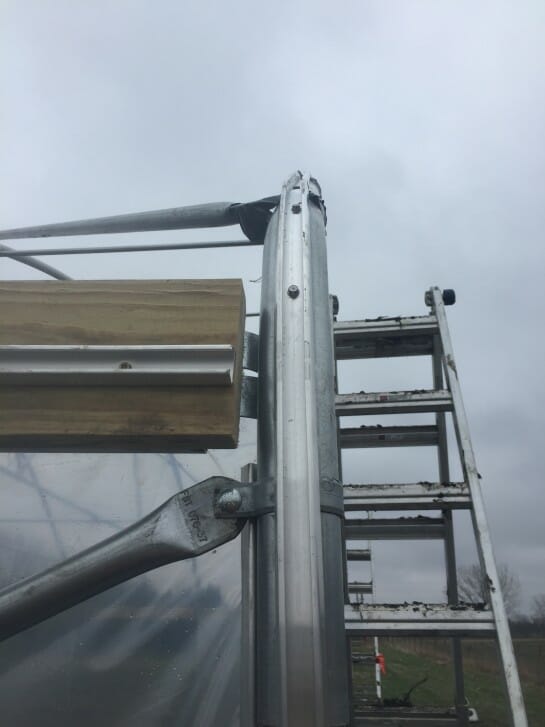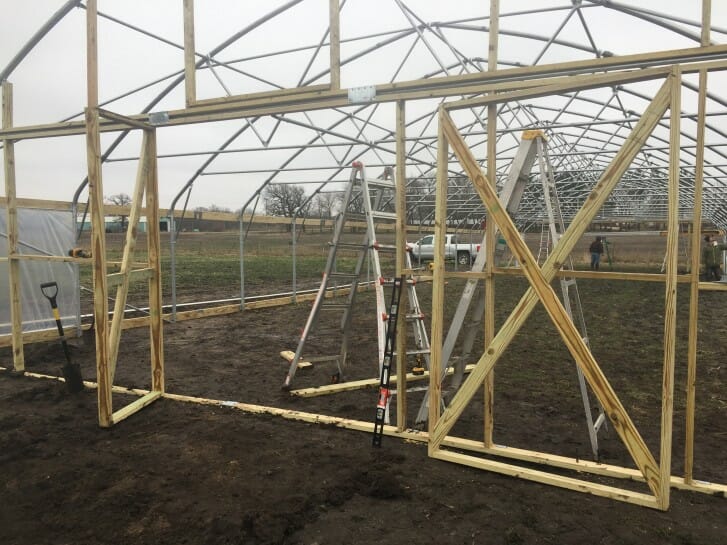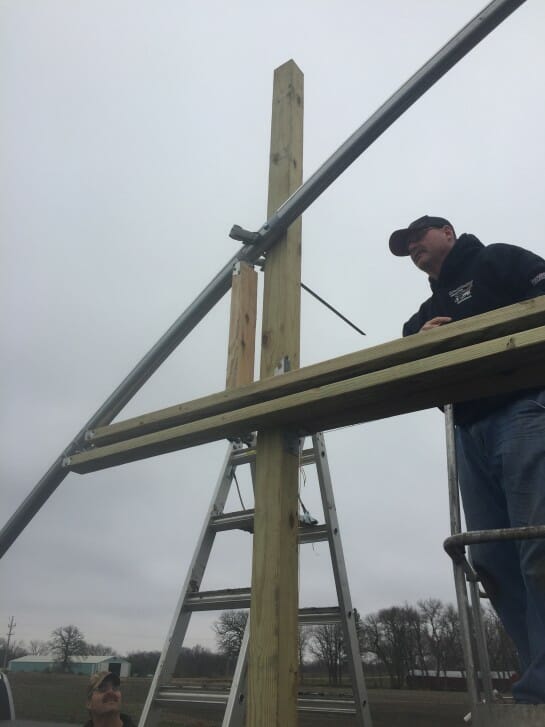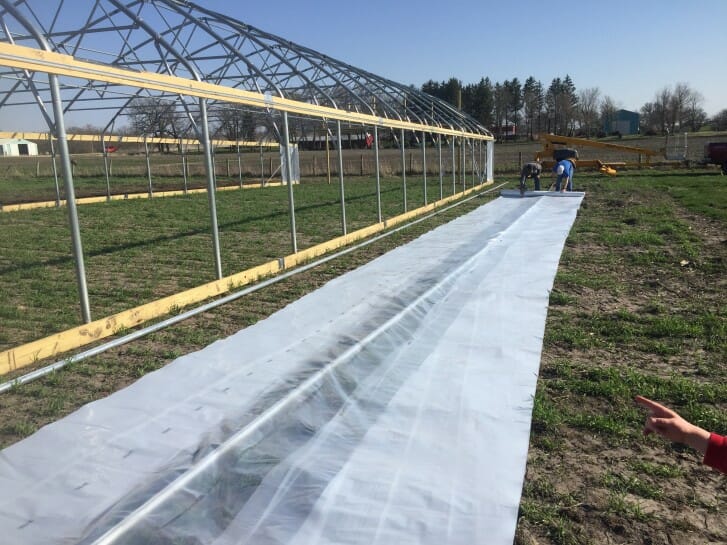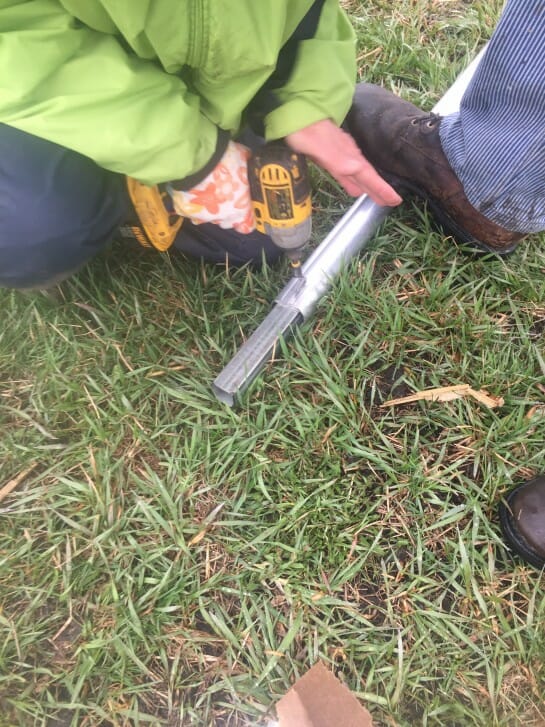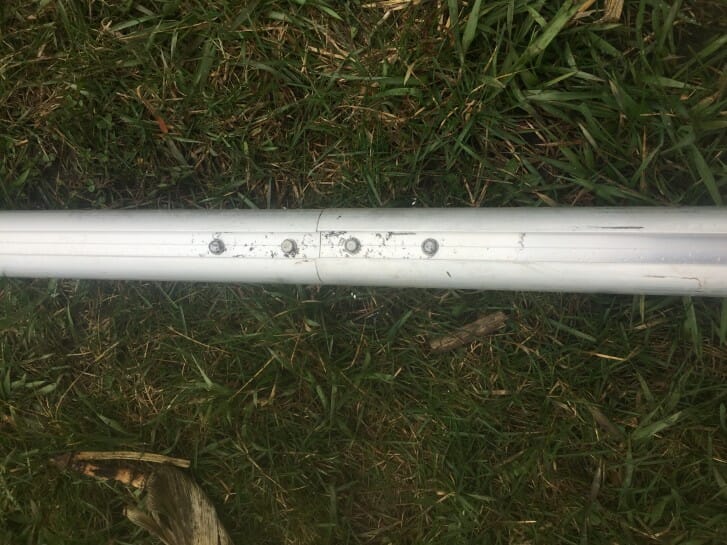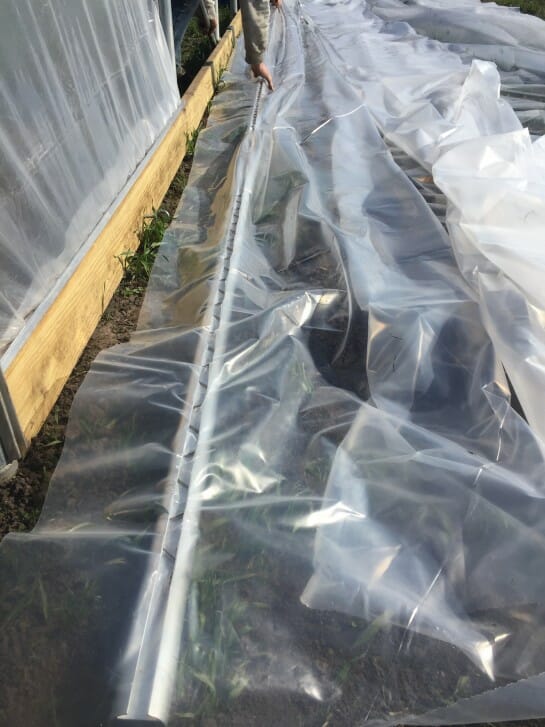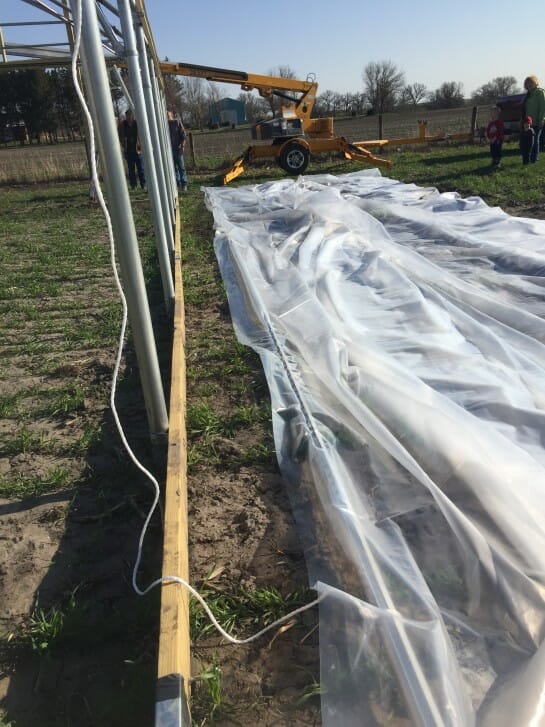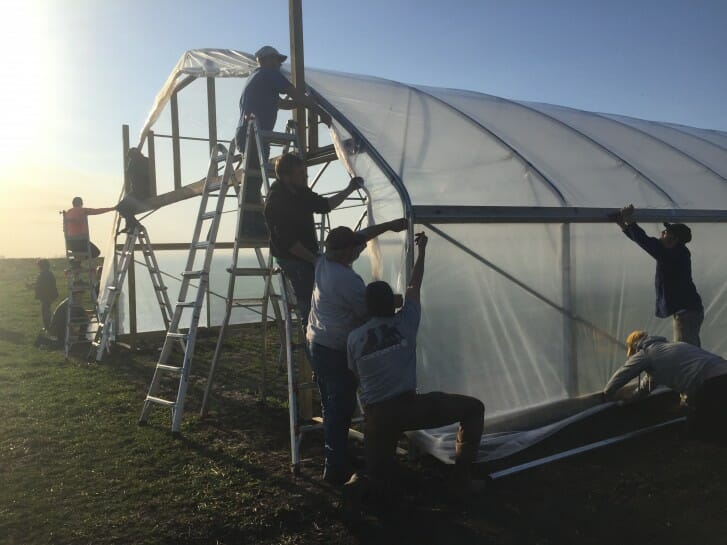Deal’s High Tunnel Build Workshop Summary
In 2015, Practical Farmers and Prairie Sky Farm hosted a workshop to build a Four Seasons Tools high tunnel. Two years later, Chris Deal, who attended the Prairie Sky high tunnel build workshop, was ready put up his own, and it was the right moment for a 2017 PFI build workshop! Much of the work was similar to the 2015 build, which we documented in a photo blog and video blog. In this workshop re-cap, I’ll highlight the differences between the two structures and the build process.
For the high tunnel build at Deal’s, the group was led by Jeff Mikesell, who installs FST high tunnels through a company called Ag Roofs. Thanks, Jeff!
Ground Posts
Chris’ site had a little slope to it, so he decided to run his high tunnel north-south to allow the slope to run the length of the tunnel. After he squared the site, the four corner posts were pounded in. We marked each post at the depth each needed to be pounded, and watched a post-level as we went. As done at Prairie Sky Farm, we used a skid loader to push the posts down, instead of a hammer. Be sure to use the ground post cap or you’ll ruin the ends! Once we had the corners in, we ran a string the length of the tunnel, tied to the ground posts at the bottom of the swage. By sinking each ground post to match the bottom of the swage to the string, we ensured the tunnel would run evenly down the slight grade.
We also used strings on each side of the ground post (top and bottom) to help keep the posts aligned. A tape measure was on the ground to ensure a post every 6 feet.
Across the tunnel (the 30 ft way) we used a string level at the bottom of the swage and adjusted the ground posts as needed (not pictured).
Building Bows
Because Chris had a 96 ft high tunnel, we used 2 stations to assemble the bows. The tunnel width is 30 ft, center-to-center on the bows. This means the outside-to-outside measure of the bows is 30′ 2 3/8″. We set up a rebar jig at 30′ 1 3/8″, which provides an inch of tension on the bow.
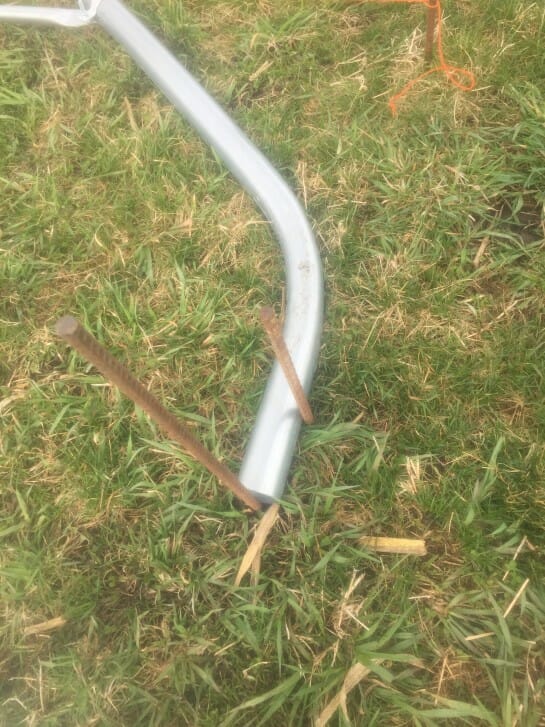
Use rebar to build a hoop jig.
The parts were sorted into piles to quickly assemble the bows with the cord and W-trusses.
First, each bow needs six brace bands; three for each side.
Next the three pieces of the bow were screwed together with 2 self-tapping screws at each connection (screws placed on the side of the bow so they don’t rip the plastic).
Loosely attach the cord to the brace bands with the bolt and nut; adjust the cord to be level with the string. Connect the three pieces of the cord with self-tapping screws.
Attach the long truss pieces to the bands at the top of the hoop, then the long and short truss to the cord. The ground should be marked with spray paint where the trusses come together along the cord, and where the brace bands on the top should be placed.
The connection of the short truss pieces to the brace bands on the side are the last thing to be tightened down. After all brace bands are tightened, each band gets 1 screw for added security.
Last, flip the completed bow over and put 1 screw on the backside of the connection points and brace bands. (Yes, the more impact drivers you have on hand, the better!).
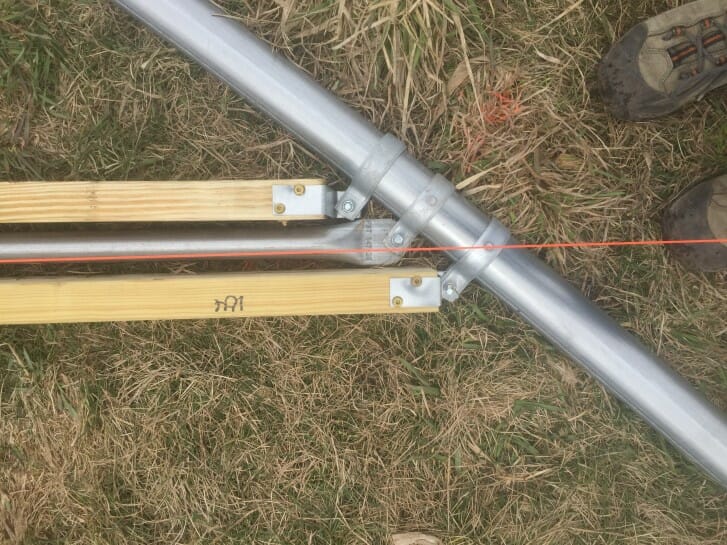
The endwalls don’t have the W-truss, but the cord is bordered by 2x6s.
With two people on ladders to balance the weight of the bow at the top, lift the bow straight up and set it first onto one ground post, then fit it to the other. Keep your hands out of the swage, and avoid having your face directly on the outside of the bow (not like Chad, in the blue shirt!). Practice with a trussed bow first, then do the end bow, which is a bit heavier and doesn’t have the trusses to hold onto.
Setting and Spacing Bows
We cut notches out of 2x4s to evenly space the bows at 6 ft. If you don’t use these jigs, the top of the high tunnel will look bumpy and uneven.
At the Prairie Sky workshop we measured and marked the purlins on the ground every 6 ft, then connected them to the bows based on the mark. This worked fine, but it sometimes took some strength to push the bow one way or the other to meet the mark (while standing on a ladder!). The jigs removed the need to muscle the bows around while up in the air. Additionally, we attached the center purlin as we put the bows up, which allowed us one fewer trip down the tunnel with the ladders. After all the bows were up and the center purlin complete, we went back and attached the side purlins. For all the purlins, we just eye-balled the straight line.
Braces and Purlins
After all the bows were put up with the top purlin on, the cross braces were secured at each end of the tunnel.
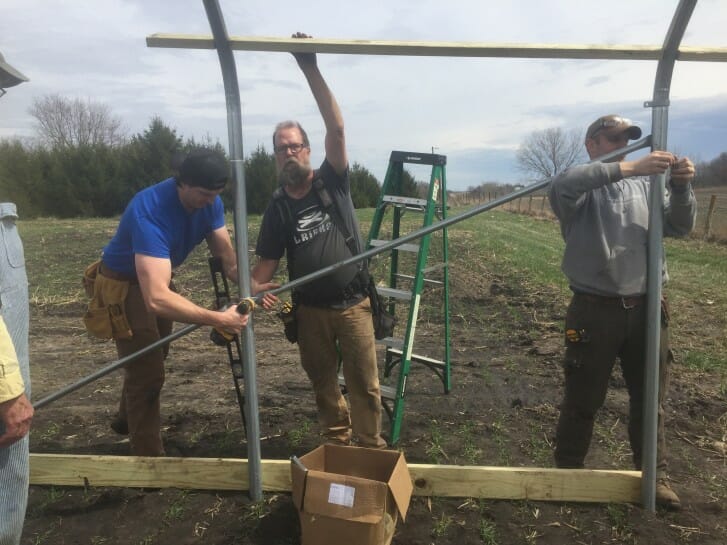
Setting the cross braces at the end of the tunnel. The braces are first connected loosely to each ground post, then secured from the lowest to highest, while checking the vertical level.
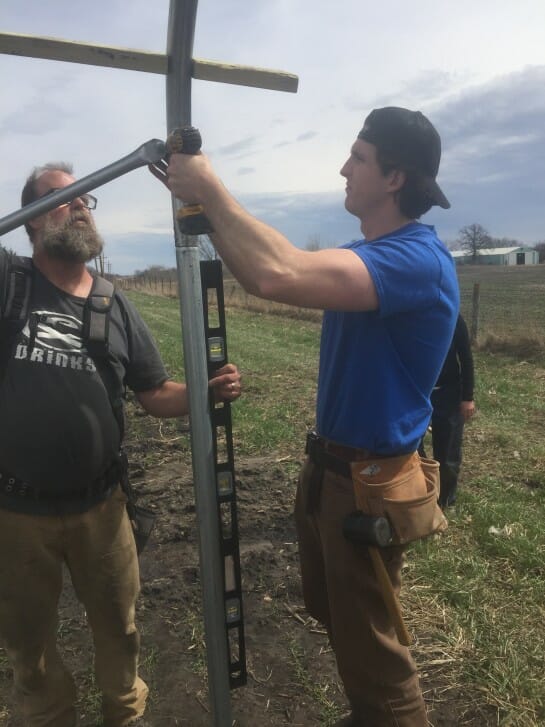
Checking the level of the end wall ground post while securing the cross brace. Notice the 2×6 jig helping to keep proper spacing while this is done.
Once the cross braces were on, the rest of the purlins were attached using the same stirrup bands. We just eye-balled the line on the side purlins, but it turned out pretty good!
At the end of the tunnel, attach the purlin end to the end wall bow. You will have to cut the purlin to fit. This last purlin before the purlin end can be the trickiest.
Having enough impact drivers, ladders and locking pliers is essential for getting the bows up quickly. Parts were laid out along the high tunnel to make work more efficient.
The purlin that runs down the center of the tunnel under the cord was hammered to a 90 degree bend so it could more easily attach to the end wall.

Elbow braces were used for extra support in this tunnel. A mark was made 50 in. from the ground to indicate the placement of the lower brace. 2×6 base boards were attached at the bottom of the ground posts.
All steel bands on the outside of the tunnel were wrapped with duct tape to prevent metal spurs from ripping the plastic. Chad and Chris, below, are first drying the bands and then wrapping with tape (yes, we enjoyed working in the rain!).
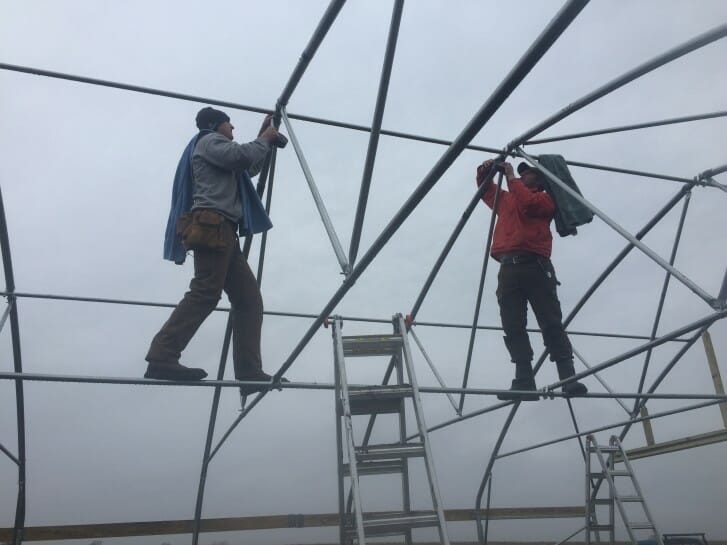
Hip Boards, Baseboards and Pocket
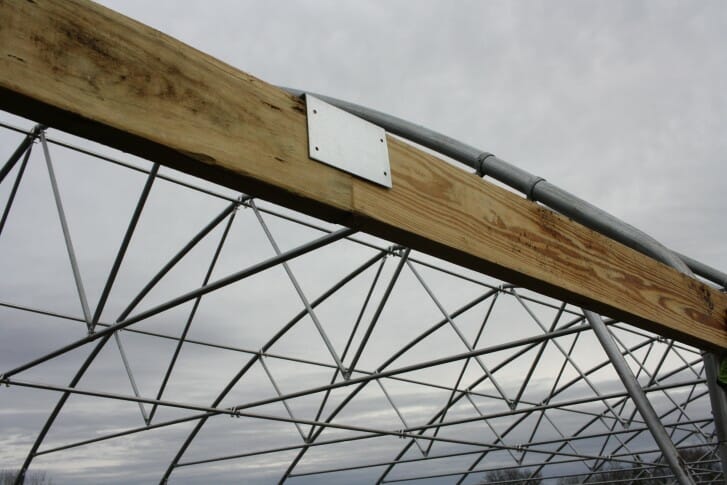
Hip board connections were secured using rectangular braces.
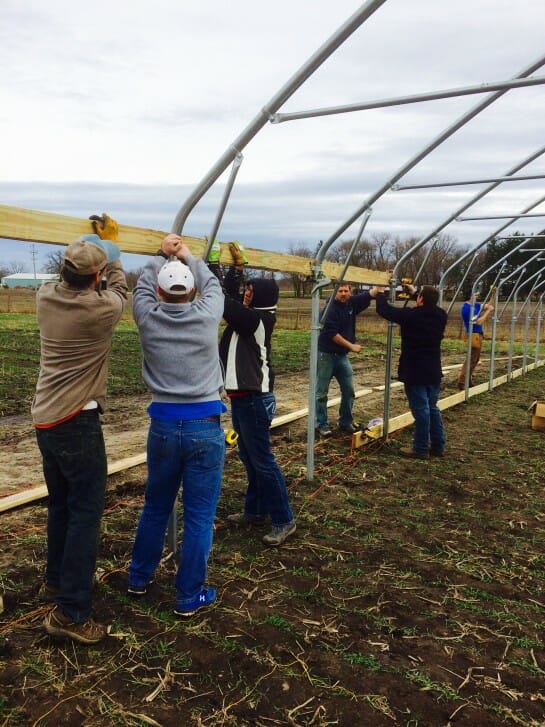
Deal’s high tunnel used wood hip boards and base boards.
2x6s were used for the hip boards and base boards. The boards were attached by double bands on the inside of the tunnel. Bands are being secured in the photo above, shown in better detail below. The bands were also secured to the bows with 2 self-tapping screws through each band. The photo (inside view of the tunnel) also shows the wiggle wire channel for the “pocket”, the square of plastic in the corner that provides additional draft protection.
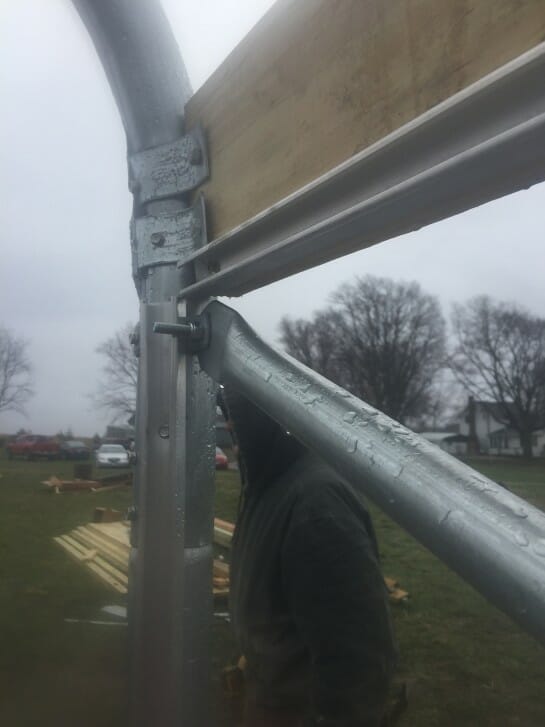
Inside view of hip board, cross brace, and wiggle wire channel for the “pocket.”
The photo below shows the completed hip board with wiggle wire channel. We used the width of a 2×6 (the 1.5 in. side) to space the wiggle wire from the bottom of the hip board. The completed pocket is also pictured below. It is held in place by wiggle wire on the inside of the hip board, base board, and both ground posts.
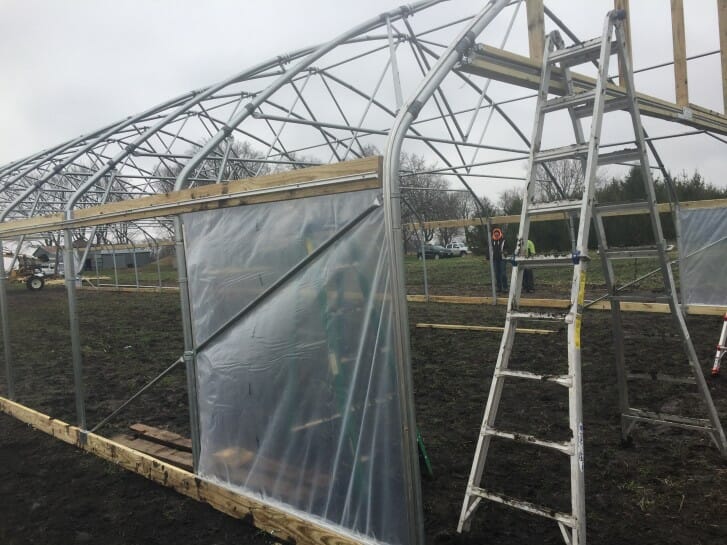
To use the wood screws through the wiggle wire channel, each hole was pre-drilled. We used 3-4 screws per piece of channel, making sure there was a screw near each piece-end.
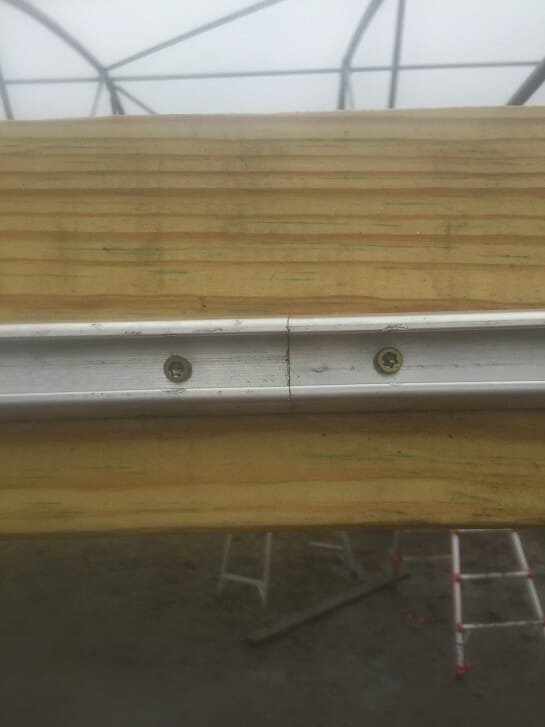
End Walls
Wiggle wire channel was put on top of the entire length of the end wall bow (to the ground), which will be used to hold end wall plastic and the tunnel plastic above the hip board.
The end walls of Deal’s high tunnel are different on each end. In the photo below, the north end wall with have two doors that swing out; one human-sized (attached on the left) the other “wagon-sized” (leaning on the right). These doors can be opened together or separately. The rest of the endwall is framed with 2x4s. We had to do a little digging on the left side to make the bottom of the end wall level (~ 3 in. difference side-to-side).
2x4s for the end wall are connected to the bows using steel bands. The photo below shows the vent frame being attached.
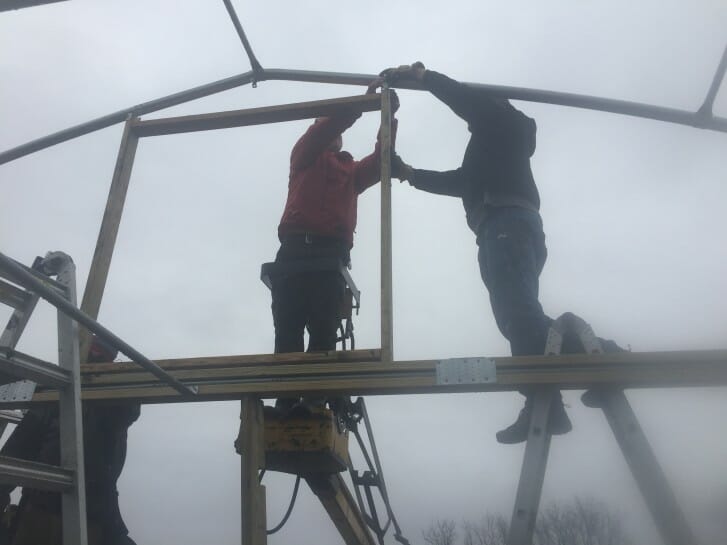
Steel bands were used to connect the bottom 2×4 of the end wall frame to the end wall ground post. Getting this band into place took some work with hammers and pliers.
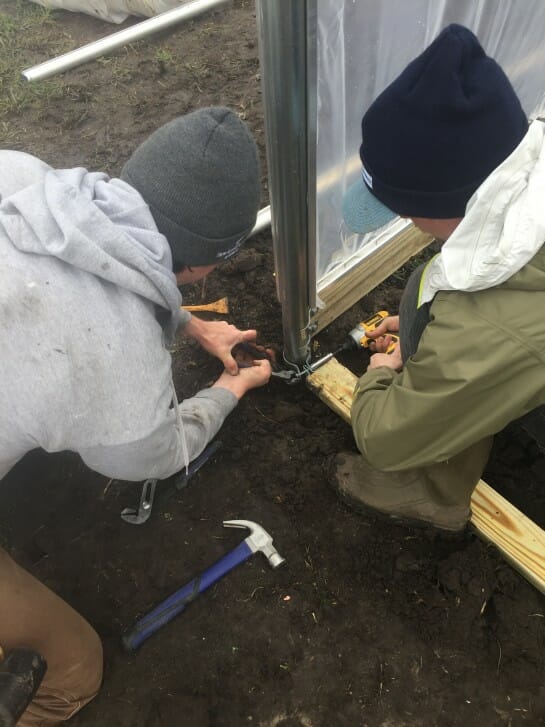
The Deals had access to two hydraulic lifts, which were very helpful when working on the end walls and pulling the plastic!
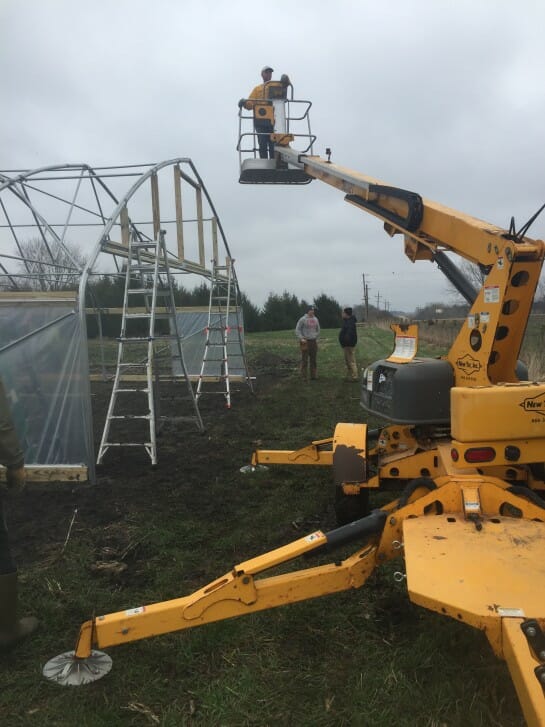
The south end of the tunnel (below) has a 22 ft-wide door to allow larger machinery into the high tunnel. The top part was framed out with 2x4s, but instead of framing the bottom, 4x4s were sunk (using an auger) and attached with large lage screws to the steel bows.
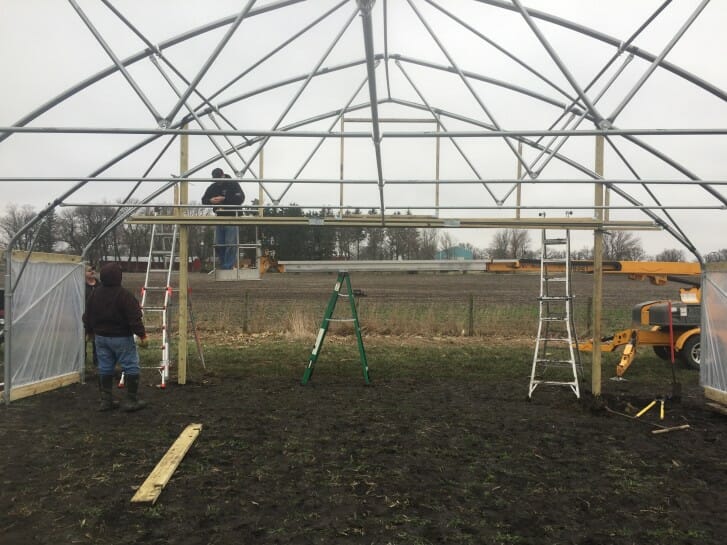
Plastic
We had a great day for pulling the plastic on: 65 degrees, sunny, and almost no wind! Last time we did this we used tennis balls to tie the ropes onto the plastic and pull the plastic over (watch the videos in the second link). This time, we secured the plastic to the roll-up bar using wiggle wire, then tied ropes to the bar and pulled the bar over with the plastic attached. This worked, but it was not as easy to manage and put more stress and weight on the plastic as it was dragged over the bows. Even though we covered all the steel bands with duct tape, we did have 1 puncture in the plastic, which luckily ended up being cut off the end. I found the tennis ball method much smoother and easier to control. Below are pictures of the roll-up bar method.
After the plastic was pulled over the tunnel. people looking over the top directed people on the ground to shift the plastic until it was straight (you can tell by the fold creases). The plastic was then attached with wiggle wire on the north end wall, down to the hip board. Once the north end was attached, people on the south end pulled them plastic toward them and down to make the plastic taught as the wiggle wire attached the plastic to the channel lock.
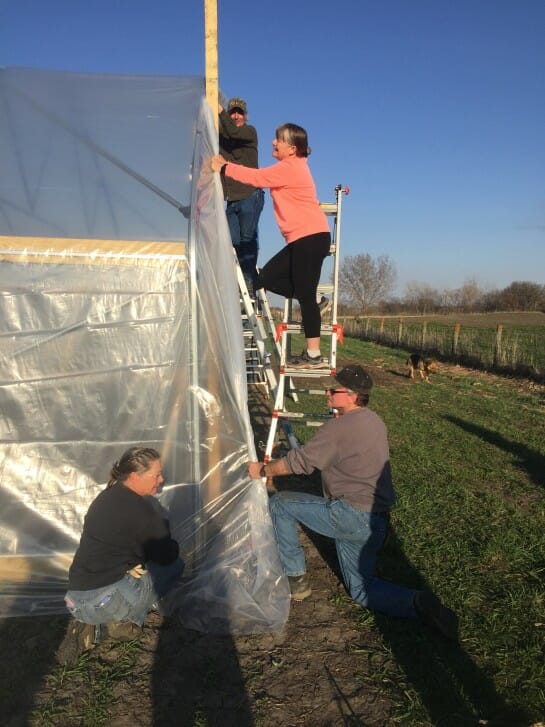
After the wiggle wire was on the end walls, it was pulled taught lower on the tunnel and secured into the channel lock on the hip boards.
Last, the group attached the bottom of the plastic to the roll-up bar using the wiggle wire. Typically the plastic is trimmed so the bar rests on top of the eye-hooks in the baseboard when rolled down. This time we chose to just attach the roll-bar at the end and roll up the extra plastic.
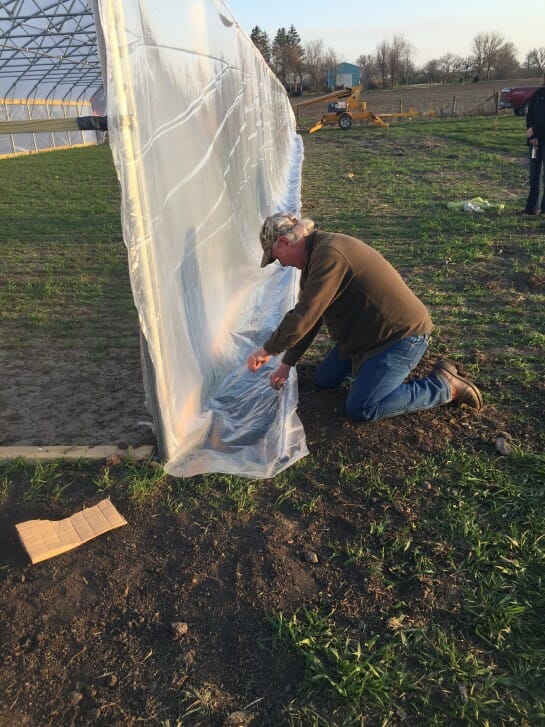
Holes were pre-drilled through the wiggle wire, hip board, and into the bows. Hooks for the anti-billow rope were then screwed in.

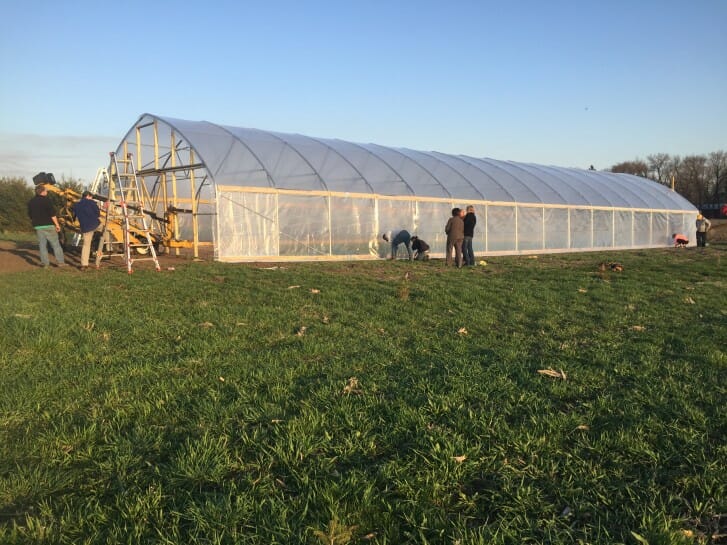
The anti-billow rope being tightened along the tunnel on the outside of the roll-up bar.
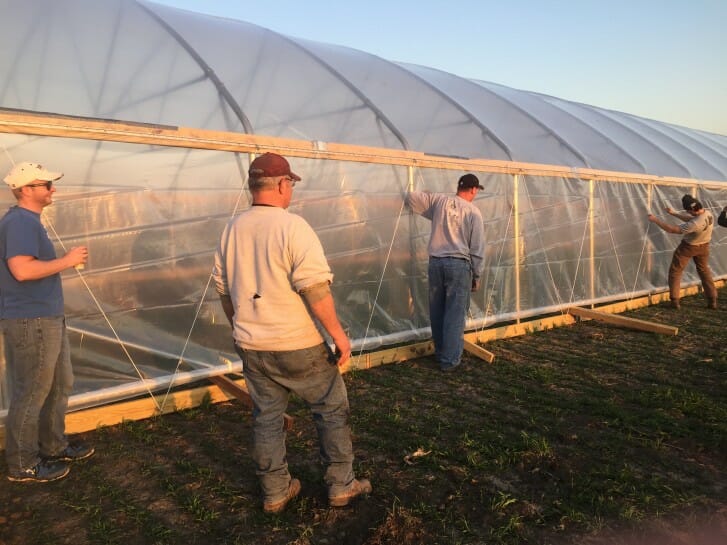
BBQ and a couple kegs of Deal’s hard cider finished the evening!
